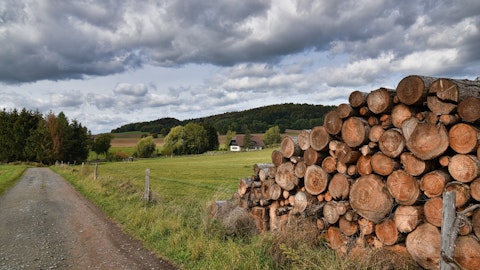Unidentified Analyst: Okay. Thank you. And then, could you also talk about your log cost benefit in Wood Products? Like, just when you see Idaho (ph) sawlogs and stuff, primarily in Idaho, are you seeing anything on the Southern side as well?
Eric Cremers: No. Our Southern prices, they’re actually up a little bit in the fourth quarter. They may be down a little bit in the first quarter, but not much. One of the benefits of having a timber business in the south is log prices tend to be relatively stable. So, we’re not seeing any real decline in the South.
Unidentified Analyst: Okay. And then just last one for me. How much is left of Deltic’s real estate development in the Chenal Valley, both in residential and commercial?
Jerry Richards: Yes. That’s a great question. I mean — and I’ll start with the high-level stats just to frame the context. So that’s a 4,800-acre master-planned community. It’s been since the late 1980s is when Deltic started that project. And a little over 5,000 total residential lots, about 1,400 remain. And then, we also have about 300 acres of commercial real estate that’s available for sale as well.
Unidentified Analyst: Okay. Thank you. I’ll jump back in the queue. Thanks.
Eric Cremers: Thanks.
Operator: Our next question comes from George Staphos with Bank of America.
George Staphos: Hi, guys. Good morning. Thanks for the details.
Eric Cremers: Good morning.
George Staphos: With Ola, you mentioned that it was coming up the curve a little bit more slowly than perhaps you’d wanted. Was that, Jerry or Eric, sort of running to demand owing to the market? Or was it true learning curve issues as you’re coming up the curve with Ola? And why was the cut rate not where you wanted it to be?
Eric Cremers: Yes, George, good question. No, it clearly was not related to the demand. Starting up a mill it’s not just an on-off switch. When we started Ola up back in late September, early October, our cut rate was around 13,000, 14,000 feet an hour. As we sit here today, last night on the night shift, we ran 31,000 board feet per hour. So, we’ve over doubled production volumes now since when we first turned the mill on. We’re still not to where we want to be. We want to get to 40,000 an hour. That’s our goal. That’s our target. That’s where we think we’re going to be at the end of the quarter. This is two steps forward, one step back when you start up a lumber mill like this. We had residuals handling issues at the very start.
We had vibration issues that we had to deal with. And we had alignment issues. Right now, we’re grappling with optimization software control issues. But we’re bird-dogging those issues. And like I said, two steps forward, one step back, and we’re moving up the ramp-up curve and we think we’ll be there by the end of the quarter.
George Staphos: It’s a lot harder probably than putting numbers in the spreadsheet. So, we’ll give you credit and appreciate it.
Eric Cremers: Thank you.
George Staphos: CapEx is guided a little bit higher than we were at and I think the Street, and obviously, you have Waldo. But is there anything else in there that we should be at least tracking progress on or asking about over the course of the year that you would point out?
Jerry Richards: Yes, I’ll start with a high level, and Eric may want to add something from a Wood Products standpoint. But you nailed it. I mean overall, $135 million to $145 million spend includes $74 million of Waldo. The rest of it, I would say, is kind of normal biz. It’s planting trees in our Timberlands business. I mean, it’s a little up a little bit because we now have more acres and higher harvest. That would be part of it. Real Estate, it’s a little bit of timing, and that’s conscious. We always stay a step ahead of demand. So, we kind of slowed down development a little bit at the end of 2022. And right now, we’re planning to potentially pick that back up — pace back up a little bit. And then, you think about Wood Products, there’s a certain level of maintenance, but there’s also discretionary projects there as well. And the discretionary, we try to always think about a return greater than 15% for those discretionary projects.
George Staphos: Thanks, Jerry. Last question for me, and this is probably more for us than for you folks. But aside from British Columbia, are there any other markets where you think the cost curve is such that capacity is going to be strained and we could see potential — at least we should be watching for potential curtailments or shutdowns?
Eric Cremers: Yes, George, I think the Pacific Northwest, the West side is vulnerable here. Those mills are competing for logs with export market logs. And they — the price of logs on the West side — mills have to make a profit if they’re going to stay open. But I think the West side is vulnerable in large part because harvesting volume that’s available to mills has been coming down. Standing timber inventories have been coming down over the past several years. We had a bunch of fires. There’s been conservation measures that have been taken. So, I think there’s the potential for further reductions over on the West side. It will be nothing like what’s happened up in B.C., but that’s probably the next most vulnerable region in North America.
George Staphos: Okay. Thanks. That’s all I got. I’ll turn it over. Thank you, guys.




